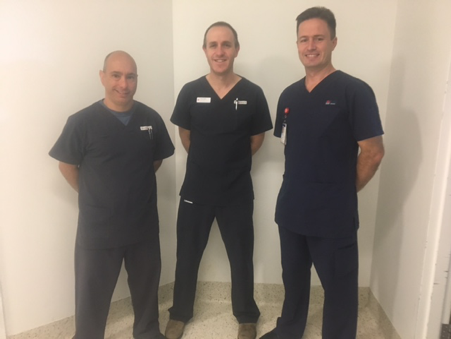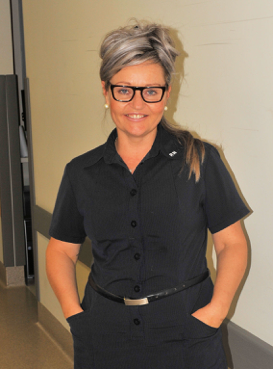Volume 3 Issue 1
Vascular access services around Australia
Tricia Kleidon, Evan Alexandrou Nicholas Mifflin & Craig McManus, Leanne Ruegg
PAEDIATRIC VASCULAR ACCESS, LADY CILENTO CHILDREN'S HOSPITAL

Tricia Kleidon
The provision of expert vascular access care to paediatric inpatients and outpatients is multifactorial. Various specialties play an important role in ensuring the right device is placed to safeguard its function until completion of treatment. An interdisciplinary approach to the delivery of healthcare, especially vascular access, is important and increasingly so with the blurring of professional boundaries. A downside to the multifaceted approach of this specialty is the confusion over ownership and overall responsibility of this specialty. In contrast to hospitals in the United Kingdom and America, vascular access teams are not well-recognised in Australia1; however, more recently in tertiary hospitals we are seeing the advent of advanced specialist nurses undertaking the role of device insertion and assuming overall responsibility for the care of these devices.
Historically, surgeons, anaesthetists and intensivists have provided long-term vascular access. The advent of the vascular access nurse as an advanced practice nurse has provided scope for nursing career development, including education at master’s level as nurse practitioner. Nurse practitioners expanding their scope of practice bring value to the hospital. Not only proficient in the use of ultrasound, sterile technique, catheter placement and tip location, they also take ownership and responsibility for planning the vascular access needs of the patient across the lifespan. This includes ensuring evidence-based practice through collaboration with academic colleagues2 and liaising with clinicians to ensure the most appropriate device is inserted at the start of treatment so replacement devices are not necessary and vessels are preserved for future vascular access requirements3-6. Vascular access is not always an exact science, and navigating the most appropriate device can be tricky. Importantly, consideration to advantages and disadvantages of each device in the context of each individual patient is paramount in this decision-making process3.
In 2015, the two paediatric children’s hospitals in Queensland merged to form one large tertiary paediatric hospital — Lady Cilento Children’s Hospital. A nurse practitioner, in collaboration with anaesthetic and surgical colleagues is responsible for the assessment, device insertion and management, and clinical teaching of all vascular access devices. Although predominantly a nurse-led service, it is a collaboration of nursing, medical, anaesthetic, surgical and other allied health professionals that ensures optimal device insertion and low rates of complication. The nurse-led vascular access service enables safe (and sometimes safer) insertion, as well as important follow-up consultancy, which traditionally did not occur with medical-led services due to competing clinical tasks7. In addition to the many clinical and practical procedures undertaken on a daily basis, the nurse practitioner collaborates with academic colleagues to initiate clinical trials in the paediatric population to ensure evidence-based practice and fewer device-related complications.
Vascular access as a specialty in Australia is in its infancy. It is imperative that clinicians do not work in silos when providing vascular access for their patient group. Collaboration is key to improving vascular access outcomes and overall hospital efficiencies.
CENTRAL VENOUS ACCESS SERVICE, LIVERPOOL HOSPITAL

Liverpool Hospital Central Venous Access Service, from left: Evan Alexandrou, Nicholas Mifflin and Craig McManus
The Central Venous Access Service (CVAS) at Liverpool Hospital commenced in 1996 and was the first nurse-led service in Australia and one of the first in the world. The service commenced as a response to the increasing workload of ICU registrars unable to provide a timely elective CVC insertion service to patients in the general ward environment. Now in its 20th year, the service has inserted over 10,000 midlines, PICCs, CVCs, vascaths and long-term tunnelled devices.
The CVAS is based in the ICU at Liverpool Hospital and provides elective catheter placement for all inpatients and outpatients, as well as providing a supportive role to the ICU by training and credentialling registrars in CVAD insertion and assisting with technically challenging catheter insertions in the ICU. The CVAS also coordinates parenteral nutrition for all hospital inpatients.
Two CNCs who job-share a 1.0 FTE position, plus a 0.2 FTE CNS, currently staff the service.
On a given day, the CVAS staff will insert an average of five catheters, and this can increase up to 10, depending on service demand and personnel availability. Insertion approaches can vary from standard peripheral (PICCs and midlines) to internal jugular, axillary, subclavian and femoral vein. Currently, the service inserts over 1200 catheters per annum and this is steadily rising. We use ultrasound routinely for all insertions except the traditional subclavian approach. For long-term devices we have used cuffed catheters, but more recently we have been tunnelling standard PICCs (access point is internal jugular and tunnelled onto chest) with good effect. For technically difficult patients in the ICU we prefer tunnelling femoral PICCs that can remain in situ for some weeks with no infectious complications.
The CVAS is involved in local and multicentre studies and has a strong affiliation with the AVATAR group, and the team were all foundation members of AVAS. Current studies include a randomised controlled trial on ECG-guided CVAD placement, midline insertion for antibiotic therapy, ultrasound-guided PIVC insertion for difficult access, as well as multicentre studies coordinated by AVATAR.
NURSE-LED PICC INSERTION SERVICE, SUNSHINE COAST HOSPITAL AND HEALTH SERVICE

Leanne Ruegg
I have been with the vascular access service at Sunshine Coast Hospital and Health Service since 2010. My background since graduating in 1992 had been emergency nursing with a 12-month stint in apheresis/haematology as I wanted to experience Monday to Friday work! That was in the late 1990s. It was there that I gained my prowess in “needle/cannulating”. I enjoy my role as CNC because I have such a hands-on, clinical component plus the non-clinical component, for example, teaching, consulting, research and quality improvement activities.
Some statistics about the Nurse-Led PICC Insertion Service and my role as CNC:
- Our staffing includes FTE 1.0 CNC, 2.5 CN FTE.
- Monday–Friday business hours PICC insertions at the patient’s bedside utilising ECG to guide and confirm tip — Bard Sherlock 3CG.
- Provide clinical troubleshooting advice and assist with difficult cannulations, unblocking PICCs, port-a-cath needling.
- Provide an expert patient-centred consultancy practice promoting early assessment of the patient’s vasculature for best IV device at the beginning of their admission.
- Review consumables with the resources NUM to standardise line dressings used within the HHS.
- Provide education and training to nursing and medical staff, PIVC cannulation credentialling and care of intravascular devices.
- Work closely with the Infectious Diseases and Infection Management departments to identify the incidence and prevalence of BSIs and plan strategies for targeted reduction.
- Promote infection prevention strategies with the assistance of medical and nursing education, media and communications.
- Coordinate the quarterly HHS audit of all vascular access devices in each clinical area.
- Present audit data to each unit manager to identify deficits and plan improvement strategies. This data is presented to the Infection Prevention and Control committee and the Vascular Access committee. (The CNC is a member on both committees.)
Outside work I enjoy time at home with my two teenage daughters, travelling, decorating, sewing and knitting, and dreaming of everything Scandinavian.
Author(s)
Tricia Kleidon, NP Paediatric Vascular Assessment and Management Service, Lady Cilento Children’s Hospital Brisbane, Qld, Australia Evan Alexandrou Nicholas Mifflin & Craig McManus, CNC — Central Venous Access and Parenteral Nutrition Liverpool Hospital, NSW, Australia Leanne Ruegg, CNC Vascular Access Surveillance and Education, Sunshine Coast Hospital and Health Service Qld, Australia Pages 26-29
References
- Chopra V et al. Vascular Access Specialist Training, Experience, and Practice in the United States: Results From the National PICC1 Survey. J Infus Nurs 2017; 40(1):15–25.
- Ullman AJ, Kleidon T & Rickard CM. The role of the vascular access nurse practitioner in developing evidence, promoting evidence-based vascular access practice and improving health services. Vascular Access 2015; 1(1):10–20.
- Simonov M et al. Navigating venous access: a guide for hospitalists. J Hosp Med 2015; 10(7):471–8.
- Moureau N & Chopra V. Indications for peripheral, midline and central catheters: summary of the MAGIC recommendations. Br J Nurs 2016; 25(8):S15–24.
- O'Grady NP. Demystifying vascular access in hospitalized patients. MAGIC makes a difference. Ann Am Thorac Soc 2015; 12(10):1434–5.
- Woller SC, Stevens SM & Evans RS. The Michigan Appropriateness Guide for Intravenous Catheters (MAGIC) initiative: A summary and review of peripherally inserted central catheter and venous catheter appropriate use. J Hosp Med 2016; 11(4):306–10.
- Alexandrou E et al. Nurse-led central venous catheter insertion-procedural characteristics and outcomes of three intensive care based catheter placement services. Int J Nurs Stud 2012; 49(2):162–8.
